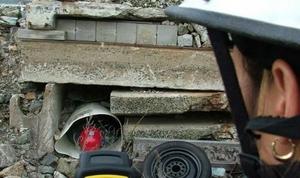Search and rescueInitial tests for buried victims rescue device completed
New victim detection device has been developed as part of a project aiming to enable people to be found quickly from under collapsed buildings or from natural elements like mud or snow; the detection device could literally be a lifeline for victims of future earthquakes, landslides, or terrorist attacks

Lifelocator detects by motion and breathing // Source: gizmag.com
A device which aims to detect trapped or buried victims in disaster situations has been successfully trialed at Loughborough University using human volunteers.
The four year project recently reached a milestone when ten brave volunteers spent six hours consecutively “trapped” in a simulated environment to help researchers implement the device to measure the chemicals in their breath and sweat. The team at Loughborough is led by Paul Thomas, Professor of Analytical Science. His team of researchers are part of the wider project being led by the National Technical University of Athens.
Professor Thomas explains:
We had two teams of 8 people working 24 hours a day using the equipment to measure the chemical profile of the trapped person. The chemical profile is very important as it can tell us where the victim is buried, if they are alive and potentially whether they are conscious or unconscious.
The device has been designed to fit into a rucksack so it can easily be carried by rescue workers. It consists of a probe which is inserted into a hole, which with large concrete structures would have to be drilled. At the end of the probe there are a range of sensors, including UV and infra-red detectors, sensitive microphones, and detectors to read chemical signals. Our role here at Loughborough has been to look at how we can ‘read’ such chemical signals in the complicated environment of a collapsed building, and the only way to do this effectively is to test it on people in a simulated trapped environment.
We have been fortunate that 10 volunteers have put themselves in this position and this has allowed us to take this project to the experiment stage. The experiments have been run under strict safety controls and there has been a lot of planning to ensure the welfare of the volunteers was at the forefront of our experiment.
The project aims to enable people to be found quickly from under collapsed buildings or from natural elements like mud or snow, so it could literally be a lifeline for victims of future earthquakes, landslides or terrorist attacks. In this experiment the materials in a collapsed building were recreated for the probe to be inserted into and readings were taken and analyzed at different levels. It has taken the team two years to get to this point of testing.
Thomas adds: “The next step in terms of testing the equipment will be hopefully to get volunteers to be ‘trapped’ for longer, for example 24 hours and to add in more confounding factors that would also give off chemicals in this kind of situation to ensure the probe is picking up the human signals, for example when a building collapses so does its sewage system so there will be a lot of chemical signals being detected by the probe. More work needs to be done before we can get to this stage and a lot needs to be taken into account of in relation to the volunteers and their welfare in this kind of situation before we can progress.”
The whole project team, which includes twenty-one partners from eleven different countries, have recently convened in Athens where the concept model was demonstrated and Professor Thomas shared the initial findings of the experiment.
